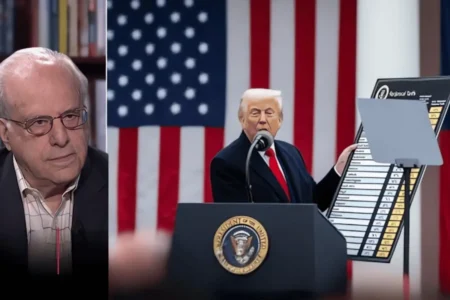It happened in the simplest way. A small news alert on a quiet Thursday: “Verizon announces new Apple bundle deal.”
For most people, it was just another headline. Another package of goodies — free iCloud here, cheap Apple Music there. But underneath all that, a deeper question buzzed quietly:
If Apple and Verizon can bundle services so smoothly in America… why can’t Apple build the iPhone here too?
The question has been hanging over Apple for years, like a stubborn cloud that refuses to float away. And now, with all eyes on tech companies to bring jobs home, it feels more urgent than ever.
The Verizon Apple Bundle Deal: What Just Dropped?
First, let’s get the facts out of the way:
- Verizon customers now get Apple One bundles included with premium plans.
- That means stuff like Apple Music, Apple TV+, iCloud storage, and Apple Arcade wrapped together under one nice, American provider.
- It’s a sweet deal if you’re glued to your iPhone and already paying for half those services separately.
The big pitch?
More savings. More simplicity. More everything — all made possible because two giant American companies figured out how to dance together.
But when it comes to the physical iPhone — the actual device you’re clutching while reading this — things aren’t nearly so cozy.
Wait, Why Isn’t the iPhone Made Here?
Short answer?
It’s crazy hard.
Longer answer?
Making an iPhone isn’t like bundling a few digital services. It’s like baking a cake with ingredients from 25 different countries, all perfectly timed, mixed, and baked in a way that costs as little as possible.
Every tiny part — the camera lens, the battery, the screen — comes from somewhere different:
- Chips from Taiwan
- Glass from Japan
- Batteries from China
- Memory from South Korea
Trying to rebuild all that supply chain magic in the U.S. would be like asking your grandma to whip up a five-star French pastry — but telling her she can’t use butter, flour, or sugar unless she grows it herself.
Apple Tried Once… And It Didn’t Go Great
Here’s a story you might not know.
Back in 2013, Apple tried assembling the Mac Pro in Austin, Texas.
It was supposed to be the start of a bold new era.
But almost immediately, problems piled up:
- Struggled to find enough skilled workers.
- Parts still had to be imported from Asia.
- Production delays stacked up.
Eventually, Apple gave up and moved Mac Pro production back to China.
Tim Cook — Apple’s CEO — put it gently: “Our products are kind of made everywhere.”
Translation?
It’s not about patriotism. It’s about survival.
So Could They Do It Now?
Technically, yes.
Realistically, no.
And here’s why:
- Labor cost: Paying U.S. workers would make an iPhone way more expensive — estimates say $2,000 to $6,000 per device.
- Infrastructure: The U.S. just doesn’t have the factories, the tooling shops, or the army of precision workers needed.
- Speed: Americans can’t match China’s fast, flexible production cycles.
As one manufacturing expert joked, “In China, you can build a city faster than we can approve a building permit.”
Fans and Critics Speak Out
The moment the Verizon Apple bundle deal was announced, the internet did what it does best: react with memes and snark.
- “Bundle my iPhone with an American job, Tim.”
- “If you can bundle Apple Music, you can bundle American jobs too.”
- “Bro, I just want free iCloud, not a $3,000 phone.”
Meanwhile, more serious voices pointed out the real stakes.
Economists warn that building iPhones in America could cause:
- Massive price hikes for consumers.
- Slower production cycles.
- Massive corporate restructuring that Apple might not survive.
In other words, the dream sounds good… until you do the math.
Quick List: What Apple Would Need to Build iPhones Here
- Build dozens of new factories.
- Train tens of thousands of specialized workers.
- Recreate an entire ecosystem of suppliers.
- Convince Americans to pay double or triple for the same phone.
Easy, right?
(Nope.)
But Wait… Why Does Verizon Pull It Off So Easily?
Here’s the kicker.
Verizon’s Apple bundle is all digital.
No factories. No parts. No messy supply chains.
It’s just software — zipped across servers in seconds.
That’s why it’s so cheap and simple compared to building physical iPhones.
When you bundle iCloud and Apple Music?
No one’s hands get dirty.
No one has to weld a chip at 2 a.m. under fluorescent lights.
When you build a phone?
It’s a whole different beast.
Memes, Jokes, and Real Frustration
This whole situation has sparked some hilarious — and painfully true — memes:
- “Apple can bundle services but can’t bundle a jobs program.”
- “Tim Cook: Here’s 2 free months of Apple Arcade. Also Tim Cook: Manufacturing in the U.S.? lol.”
- “New iPhone: $3,000. Comes with a free apple pie.”
Funny? Yes.
But it also taps into a real frustration:
Americans want good jobs. They want good phones.
They just don’t want to pay $6,000 for them.
What About Future Moves?
Apple isn’t sitting still.
They’re quietly shifting some production out of China — to India, Vietnam, even Malaysia.
But guess what? None of that means bringing factories back to Ohio or Texas anytime soon.
Tim Cook even said tariffs (thanks, politics) forced Apple to diversify — but not “repatriate” manufacturing.
Bottom line:
It’s about spreading risk.
Not about fulfilling anyone’s American Dream.
Bigger Picture: The Verizon-Apple Dance
The Verizon Apple bundle deal shows something important.
Big companies know how to move fast when it’s cheap, safe, and digital.
That’s why bundling services feels easy.
Building phones?
That’s messy. Expensive. Complicated. Risky.
And big companies hate risk almost as much as they love profits.
Final Thought
When the next shiny Verizon Apple bundle deal pops up, enjoy it. Grab the free iCloud storage. Blast your Apple Music playlists.
But when you hold your iPhone in your hand, think about everything that had to happen to get it there.
The factories. The workers. The global logistics. The midnight welding shifts. The dream that — right now — only works thousands of miles away from home.
Because bundling services is easy.
Bundling the American dream?
That’s still the hard part.







